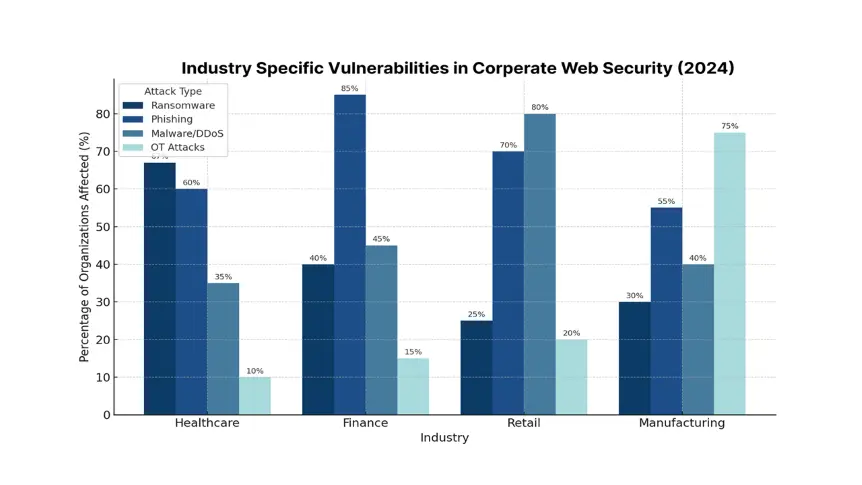Published Date : 15 October 2025
Posted by : Preeti Wani
As digital transformation accelerates, the threat landscape facing businesses is becoming increasingly complex and perilous. Organizations today rely heavily on digital infrastructure to run operations, serve customers, and manage sensitive data. With that reliance comes greater risk. From data breaches to ransomware attacks, the costs of poor web security are no longer theoretical; they are real, rising, and increasingly devastating.
Cybercrime is expected to cost a staggering $10.5 trillion in global damages by the end of 2025, according to recent projections. For businesses, this is not just about safeguarding against financial loss; it is also about preserving brand reputation, meeting regulatory requirements, and avoiding expensive disruptions to business operations. The need for solid security frameworks is evident in the growing demand for cybersecurity solutions. According to Research Nester’s survey, the global web security market is likely to rise from $6.5 billion in 2024 to $10.9 billion by 2035, registering a CAGR of 10.8% during the forecast period.
What Is Corporate Web Security?
Corporate web security encompasses the tools, strategies, and policies that organizations use to protect their online assets, websites, web applications, data systems, and internal networks from cyber threats. These threats can take many forms, including phishing scams, malware, zero-day exploits, SQL injection, cross-site scripting (XSS), and Distributed Denial-of-Service (DDoS) attacks.
The IBM Cost of a Data Breach Report (2024) discloses that the average cost of a breach has climbed to $4.45 million, marking a 15% increase over the past three years. What's more alarming is that nearly 43% of these attacks target small and medium-sized enterprises, or organizations that often lack the basic resources to defend themselves effectively.
The Expanding Threat Landscape
As companies adopt cloud services, hybrid work models, and mobile access, they inadvertently broaden their attack surface. Technology may be developing, but so are the tactics used by cybercriminals. Hence, here’s a closer look at some of the most pressing threats:
Phishing and Social Engineering Attacks: Phishing remains one of the most common and successful forms of attack. Cybercriminals often impersonate trusted entities through email or fake login pages to steal user credentials. The 2024 Data Breach Investigations Report revealed that 36% of all data breaches were phishing.
Ransomware and Malware: Ransomware has turned into one of the most damaging cyber threats. Criminal groups now operate like businesses themselves, demanding millions as extortion money to unlock stolen data. According to Cybersecurity Ventures, ransomware-related damages could reach $265 billion annually by 2031, with a new attack expected every two seconds as compared to every 11 seconds in 2021.
Insider Threats: Whether intentional or accidental, insider threats are increasing. The 2024 Ponemon Institute study found that insider incidents have increased by 44% over the past two years, and the average cost per incident now exceeds $15.4 million.
Zero-Day Exploits: These attacks target software flaws that developers are unaware of, making them particularly hard to stop. In 2023, the Cybersecurity and Infrastructure Security Agency (CISA) stated that nearly 60 zero-day vulnerabilities were actively exploited before patches could be released.
Industry Specific Cyber Threats:
Different industries experience different threat vectors depending on their way of operation:
- Healthcare: Faces targeted ransomware attacks due to sensitive patient data.
- Finance: Prone to phishing, credential stuffing, and wire fraud.
- Retail: Hit with card skimming, POS malware, and DDoS attacks.
- Manufacturing: Threatened by operational technology (OT) attacks disrupting supply chains.

Why Corporate Web Security is Important
- Data Privacy and Regulatory Compliance: Businesses are under rising pressure to comply with privacy regulations such as GDPR, CCPA, and HIPAA. Failing to meet these standards can result in steep fines. A high-profile example came to highlight in 2023 when Meta Platforms was fined €1.2 billion for violating GDPR rules over transatlantic data transfers.
- Business Continuity: A cyberattack can grind operations to a halt. In March 2024, Change Healthcare, a subsidiary of UnitedHealth Group, was affected by ransomware, halting medical billing nationwide and costing the company more than $1.6 billion in damages and lost revenue.
- Trust and Reputation: Customer trust is fragile. A breach not only causes immediate financial loss but can also damage brand reputation. According to PwC’s Global Consumer Insights Report, 87% of customers say that they would stop continuing their business with a company that isn't trustworthy to handle data responsibly.
- Investor Confidence: Investors choose cybersecurity as a crucial factor in corporate governance. According to Accenture, 68% of institutional investors say cybersecurity is a key consideration when evaluating corporate risk.
Top Elements of Corporate Web Security
To effectively protect against the rising tide of cyber threats, businesses must implement a multi-layered approach to web security. Here’s what it consists:
- Secure Web Gateways (SWG): These tools track and filter incoming and outgoing traffic, blocking access to harmful sites and enforcing corporate browsing policies.
- Web Application Firewalls (WAF): WAFs shield web applications from known vulnerabilities like XSS and SQL injection by filtering and monitoring HTTP traffic.
- Endpoint Detection and Response (EDR): EDR solutions continuously track endpoints such as employee laptops or mobile devices for abnormal behavior and provide real-time threat analysis.
- SSL Certificates and HTTPS: SSL encryption ensures that data sent between users and websites remains private. Google Chrome’s Transparency Report shows that over 95% of web traffic is encrypted now, reflecting widespread industry adoption.
- Security Information and Event Management (SIEM): SIEM systems collect and analyze log data from all across the organization to detect suspicious patterns and potential threats.
- Constant Vulnerability Testing and Penetration Simulations: Regular security assessments, involving ethical hacking and vulnerability scans, support businesses to detect weaknesses before cybercriminals do.
What’s Changing: Trends that Will Define the Future of Corporate Web Security
The world of cybersecurity is constantly shifting. Given below are some emerging trends companies should be watching:
- AI-Based Threat Detection: AI plays a major role in threat identification. AI tools can detect patterns and flag anomalies faster than human teams, and by 2026, AI-driven solutions are likely to detect up to 90% of cyber threats in real-time.
- Zero Trust Security Models: The Zero Trust strategy assumes no one is trustworthy by default, regardless of whether they are inside or outside the organization’s firewall. Every access request must be verified. It depends on never trust, always verify approach.
- SASE (Secure Access Service Edge): This cloud-native solution combines security and network connectivity. Gartner predicts that by 2025, 60% of enterprises will have adopted SASE frameworks.
- Cloud-Native Security: As businesses move their operations to platforms like AWS, Azure, and Google Cloud, they require tools specifically built to secure containerized applications, microservices, and serverless functions.
Best Practices for Corporate Web Security
To ensure comprehensive protection, organizations are expected to adopt the following best practices:
- Educate Employees: Over 90% of cyber incidents stem from human error. Regular security awareness training can reduce phishing success rates.
- Implement MFA (Multi-Factor Authentication): Adds a critical layer of security beyond passwords.
- Backups and Disaster Recovery: Keep encrypted backups and a reliable incident response plan.
- Monitor Third-Party Access: Vendor and partner portals are the most common attack vectors. Thus, ensuring strict access control should be the top priority.
- Automate Patch Management: Unpatched vulnerabilities are a main cause of breaches.
Conclusion
As digital transformation reconstructs the global business landscape, corporate web security must be viewed as a strategic asset, not just an IT function. Businesses that neglect it do so at their peril, facing not only financial losses but legal liabilities, operational disruption, and irreparable damage to customer trust. With cyberattacks becoming more complicated and frequent, the question is no longer if a company will be targeted, but when. Proactive investment in a robust, scalable, and modern web security framework is the only way forward.
Contact Us







